Considering it is such a niche hobby Bloodbowl is surprisingly well served with independent model manufacturers. This page gives links to a number of sites with a great selection of Fantasy Football miniatures available.
However if you can’t find exactly the right models, have a special theme in mind, want a team that stands out from the crowd or wish to save money by using models already in your collection, then conversions are the way to go.
This article will specifically deal with converting Blood Bowl models. I will mention some standard techniques used but won’t go into detail on these as there are numerous great articles out there about conversions in general.
Adding variety to your players
If you buy a fantasy football team then it is often the case that there will not be 16 unique models, most commonly duplicates will be found amongst linemen or 0-4 positionals. As Bloodbowl teams are so small it is less daunting to have 16 unique players. This also has practical implications since it will help identify each player beyond looking at their team number. You may even have created a background of each player before the team was created, or develop it based on their performance on the pitch and wish to reflect this in the model. If the player has access to mutations then there is a very real and practical reason to convert to show these on the model.
If you regularly play against strangers in leagues or tournaments then it is important that your opponents can easily differentiate between the positions and individual players. Otherwise you risk the game being held up when they have to keep asking what each model is.
Plastic versus Metal
Both materials have their advantages and drawbacks for gaming and converting.
Plastic is light and easy to cut, it can also be very strongly attached to other plastic parts using polystyrene cement, allowing much flimsier and more dynamic poses. By applying heat from a hairdryer you can even bend limbs or alternatively cut and repose a model without loss of strength.
Plastic models tend to come in multi-part kits allowing greater scope in pose ability and opportunities to kit bash by mixing parts from other kits. One very important advantage is that plastic model chip less easily and can survive being dropped, useful if you are clumsy.
Plastic models tend to be cheaper, but as it is GW with the widest selection of suitable models this may not always be the case. The lightness of the plastic can be a disadvantage as some coaches dislike the feel of the models and they are more likely to get knocked over or blown away when playing a game. This can be mitigated somewhat by weighting the base, either using coins or specially designed weights that fit under round bases. Alternatively a hybrid can be achieved by combining the legs and/or torso of a metal model with plastic parts.
Recruiting from other sources
A great source of conversion options can be gleaned from other fantasy ranges as most of the Bloodbowl races are pretty generic. Science fiction offers some good options, particularly if you favour the 2nd edition style as certain sci-fi armour is closer to American football armour or general sports kits than the fantasy equivalents. In either case by opening up your horizons to other sources it vastly increases your conversion options.
The most obvious point of call is models designed for fantasy games, Warhammer or otherwise. These often have direct equivalents and particularly the GW BB range from 3rd edition onwards, they often looked just like warriors had just stepped off the battlefield and stowed their weapons.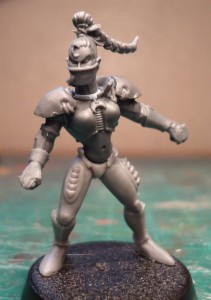
Sci-fi models can often be surprisingly good choices for conversions; many of them wear outfits that resemble modern sportswear and their armour is often closer to the blood bowl style than the fantasy equivalents. However unlike fantasy there is a lot less representation of the non-human races available amongst these models.
The danger with this is that your team may end up looking more like a Mordheim/Necromunda gang that a team of athletes. All too often it is really obvious that weapons have been removed and the players end up with the dreaded “weaponsnipitis”, the hand and arm looking awkward and obviously missing a weapon. The best way round this is to find a hand or arm from another source and swap it in.
This model is entirely made from 40K parts, her body, head and arms and from the dark eldar range and the shoulder pads from kroot warriors, her legs are from old 4th edition plastic dark eldar warriors with spikes removed. Her clothing is tight fitting but has some flat armour plates, quite similar to modern sports clothing with padding to give protection from falls and minor collisions, ideal for AV7 players. This was a test model and the hands are the weakest area, the right in particular suffers for being in a pistol grip, ill-suited for a Blood Bowl player.
Kit Bashing
This is one of the easiest ways to convert models and a great place to begin. Many model kits are available in kit form; with multiple head, chest and limb options as well as optional equipment. This is most commonly seen are the GW plastic kits from their WHFB and 40K ranges. However there are plenty of metal and resin models from other suppliers that come in separate parts.
“Kit-Bashing” involves taking parts from 2 or more model sets and combining them, say the body and legs from a sci-fi model combined with the heads and arms from a fantasy one. I am a big fan of plastics models that have a lot of parts in each kit as these open up so many possibilities and are easy to convert. There are also a few Bloodbowl specific kits from Impact and other sources designed to assist in the conversion of other models.
GW prices are high enough to make buying the whole models an expensive prospect, much less just to use a few spare parts. A far more economical solution is to use the various bitz services available online or through e-bay.
These High Elf blitzers (or Dragon Warriors as they were called in 3rd edition) are very simple conversions using all plastics, the top half is from the dragon prince with the weapon cut off and the legs from a dark elf corsair.
The chaos pact marauders are made from Empire Greatswords legs and torsos, arms from impact, shoulder pads from chaos marauders and heads from chaos knights/ chaos space marines, some with horns cut off.
Repositioning
Whether you are using multi-part kits or single pose models, adding variety to their positioning can help make key players stand out and differentiate positionals. A lot of the older metal bloodbowl models tend to suffer from static poses due to the limitations of the older casting technology. Thanks to 3D printing and advances in model designs and casting we have a lot more dynamically posed models available than in the past.
Multi-part kits are the easiest way of allowing you to personalise how models are positioned. The great thing about these is that you can more easily adjust the poses of heads and limbs meaning that 2 models with identical parts can be made to look quite different.
This model is made from identical parts with the first being positioned in a more static lineman pose and the second in a dynamic thrower pose.
A more involved conversion is to cut up limbs to more drastically alter the position of the model, this may require pinning or some filling afterwards. This is a particularly useful way to help set positional players apart from linemen if they have similar kit. Linemen suit more static poses as they get stuck marking big guys or on LOS duty. Runners and blitzers look good running forward, catchers can either be positioned running or jumping for the ball. Throwers look good with the classic pointing hand and twisted body or with the ball ready to pass it.
These norse players are kit bashes with parts taken from a variety of sources. The 2 models on the left have been modelled to represent throwers and the 2 on the right berserkers.
Alternatively parts can be taken from other models that are already in the correct position or have the bits needed. If you have a model you think would make a good looking blood bowl player they often chopping the arms off an existing BB model and sticking them on will be enough to transform them.
This can be a pretty simple conversion and bad joins between the arm and body can be covered up with shoulder pads. Head or leg swaps can equally help transform models in particular if they have signature parts such as catching gloves.
These Amazons have torsos, arms and heads taken from the Mordheim Amazons. With the careful choice of which models to use and the addition of legs and hands from other models they have been converted into catchers and throwers respectively.
Adding Blood Bowl equipment
If you are going to use non-Blood Bowl models then the best way to convert them for the pitch is to add suitable equipment, you may also wish to add extra kit to some models. This will help indicate their armour value; AV7 norse linos get a shoulder pad and loin cloth if they are lucky , whilst AV9 dwarf blockers may have their lower lip as the only bit of flesh on display. It also gives you something to paint the team colours on and help tie the team together if they are made up of many disparate races.
Helmets/Heads
Despite not being known for their intelligence, many Bloodbowl players still try to protect what little is left of their brains. A helmet does suggest higher AV, pushing a half naked model from looking like AV8 rather than 7. A handful of races do have access to separate heads available, making this a very easy way to convert players. Another option is to chop heads from existing BB models, but that can be pretty expensive if the rest of the model parts are not going to be used.
A more cost effective method is to buy spare plastic heads or cheap models that you can chop up. There are some heads with helmets that already resemble those of Bloodbowl players, meaning just a simple headswap is all that is required. In particular sci-fi or contemporary army models are a good source of this as their helmets are close to American football helmets. Fantasy helms may be a little trickier, removing some detail may be required. If you like the 3rd edition look then some teams can use helms direct from the fantasy range. Another option is to chop the top of the model’s head off and then stick a helm onto it or sculpt one. Further decoration can be added to these heads, ear protection and a chin strap make a great vintage looking football helmet. A face guard can be added to some fantasy style helmets using wire or putty rolled into sausages and stuck on.
This troll had the top of his head sanded and a trimmed down ogre helmet stuck on top. The face guard is a paper clip that was glued into holes drilled in his head.
Shoulder Pads
By far the easiest Bloodbowl conversion is adding shoulder pads, this is especially true for lower armoured models. If you are just starting out with converting or are nervous of making mistakes then this is an ideal starting point. Cool looking teams can be achieved by taking fantasy or sci-fi models, removing the weapons and adding shoulder pads. Some great sources of these are plastic shoulder pads from Orks, Warriors of Chaos and Dark Eldar being particularly well served, though Space Marines have potential as well. These pads will fit most models, in some cases a bit of trimming or sanding of the model’s shoulders may be needed.
Shoulder pads that are part of a model can be cut off to be used on others, but this is a more involved conversion and pretty ruinous to the donator model.
These Nurgle warriors are made from chaos space marines bodies with arms from the fantasy range. The plastic shoulder pads help give them a more fantasy and Blood Bowl appearance.
Loin Cloths
These are better suited to the more primitive or lower armoured teams. Often the purpose will be to tie a team together or differentiate positionals rather than offering protection. There are some multi-part models that come with separate loin cloths, but most of the time it will involve removing them from another model and fitting them to your players and will be a more complex job.
For larger models the 40K Ork range has some great loin cloths and these can be attained from bitz providers. For smaller models, dark eldar warriors or dire avengers have some options, but these will often require trimming of the cloth or legs of the model itself.
The addition of some Dwarf shoulder pads went a long way to transforming this saurus into a blood bowl player. They have also had loin cloths added to give another item to paint the team colours on.
Hands
After shoulder pads, I consider hands the most important part when converting sci-fi or fantasy models. Sci-fi models in particular holding guns can be especially tricky as just chopping the weapons off looks really awkward.
Finding suitable hands is tricky, as most non-Bloodbowl models will be holding a weapon in at least one of their hands, usually the right. There is also an issue of size of the hands and type, an Orc has a very different looking hand compared to an elf.
It is possible to cut the weapons off certain hands and have them still look ok, those holding thin items like drumsticks or manning a pintle-mounted weapon are ideal. You can either cut the weapon off flat or drill it out. Another option is to paint the hole you would see in the middle of the fist. Gloved hands work best for this as they can be cut off part way up the forearm and then rotated giving more posing options.
Bitz services are a great source of parts and there are arms available through existing Blood Bowl players. Often command models are good sources as they will have certain hands without weapons and these tend to be less commonly taken.
These Chaos Dwarfs have hands taken from other Blood Bowl miniatures, though 1 of them is a weapon snip.
Extras
These can be a nice little touch to push a model over the edge to being a BB player but are harder to find sources from. Things like elbow and knee pads or forearm and thigh guards will add a little extra touch that can help push a model from AV7 to 8 or make them look less like a fantasy/sci-fi soldier.
They can be chopped from existing models, to save on cost, a heavily armoured player may have hands, elbow pads and shoulder pads that can be spread across 3 lighter armoured players. Alternatively they can be sculpted by hand, as they are smaller and simpler bits of armour this is less taxing than adding helmets or shoulder pads.
These slann have both forearm and thigh armour taken from other BB models. These were added to the loin cloths and shoulder pads to push them up to AV8. Their helmets were sculpted from greenstuff and had topknots added.
Conclusion
This has just dealt with the basics of converting; the main aim was to deal with generalities on how to convert BB models.
A follow up article will deal with tips to help your Blood Bowl players stand out from each other. This will cover how to make star players and positionals stand out using both painting and converting techniques.
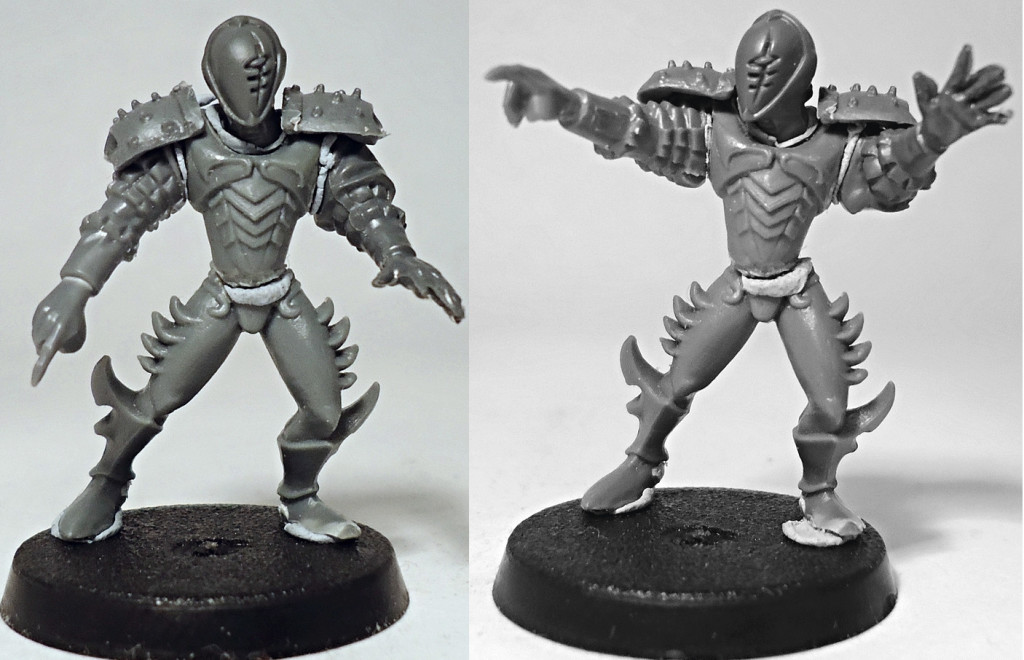
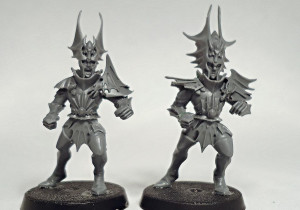
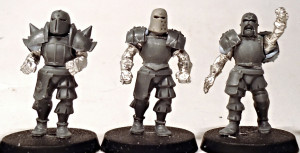
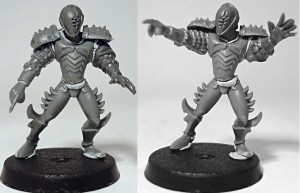
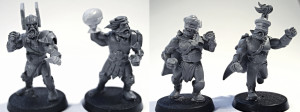
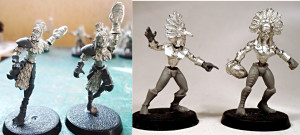
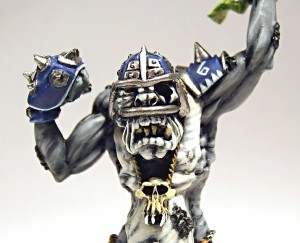
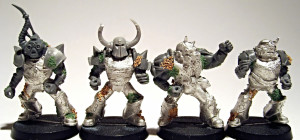
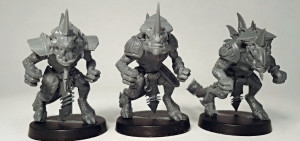

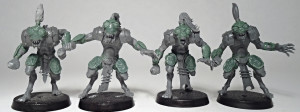
Spot on with this write-up, I absolutely think this website needs a lot more attention.
I’ll probably be returning to read through more, thanks for the info!
Great article. I saw your Rumblelow Sheepskin conversion (loving it!) and wondering where you sourced the boar and stag parts for the ram?
Thanks, the body comes from the classic plastic orc boarboyz. The head and tail comes from the stag from Wood Elf wild Riders, the knee pad from a halfling shoulder pad and the horns are from a beastman, rest is greenstuff.